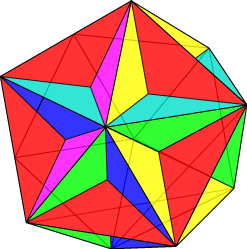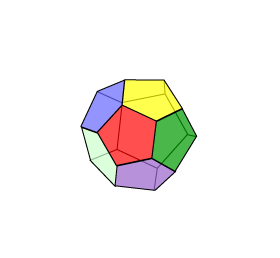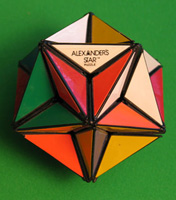|
{5, 5/2} or (5)5/2 Our next Kepler-Poinsot polyhedron is the great dodecahedron, illustrated at right. It has intersecting pentagonal faces (indicated by the ‘5’ in the symbol), and each vertex figure is a pentagram {5/2}. To understand the structure of this solid better, it will help to observe that it is built around a regular dodecahedron, and the final figure is inscribed in a regular icosahedron. We are now going to determine the number of vertices, edges and faces. In determining the number of faces, again remember that it is the whole pentagons that make up the faces here, not the individual parts. Similarly, the vertices of the solid are where the (five) vertices of the pentagonal faces meet. And the edges are the long (not completely visible) line segments joining the vertices.
Since each pentagonal face is centred on the face of the inscribed 12-faced regular dodecahedron, F = 12. And since the vertices coincide with the vertices of a regular icosahedron, the number of vertices of this solid is also 12. For the edges, each of the 12 faces has five edges, giving a count of 5 x 12; since each edge is counted twice in this calculation, we deduce that E = 30. We observe the number –6 which appears, not quite so unexpectedly as before, in the Euler formula.
We observe that in this case, V = 12 = F, and E = 30. These figures are exactly the same as those obtained for the small stellated dodecahedron, but the critical fact for establishing duality is that the value of V for the great dodecahedron is the same as the value of F for the small stellated dodecahedron, and conversely. The dual nature is also reflected in the symbols for the solids:
We saw previously how the small stellated dodecahedron can be obtained from a dodecahedron by ‘stellation’ – extending the faces until they meet again, so forming the new solid. The great dodecahedron can also be obtained by stellation: starting with the small stellated dodecahedron, we can extend the faces to obtain this new solid. Another way of saying this is to call the great dodecahedron the second stellation of the dodecahedron.
As with the Platonic solids, we can use this Java applet to play with each of the Archimedean solids. Perhaps you can find some interesting new property! It is not impossible: new results are being discovered in elementary geometry even today. The only reason they have not been discovered before is that no-one thought to ask the right question.
There is a version of the Rubik’s Cube in the shape of the great dodecahedron.
The model of the small stellated dodecahedron is easy to make. See this construction page for some details.
It is a simple matter to derive a set of vertex coordinates for the great dodecahedron. For, as the figure at right shows, these vertices are just the vertices of a regular icosahedron. Hence from our previous work, we can take the 12 vertex coordinate sets to be: (
MathWorld : http://mathworld.wolfram.com/GreatDodecahedron.html Wikipedia : http://en.wikipedia.org/wiki/Great_dodecahedron
|
 GREAT DODECAHEDRON,
GREAT DODECAHEDRON,  We can understand the construction of the great dodecahedron better by visualizing how the faces are constructed, starting with an icosahedron.
We can understand the construction of the great dodecahedron better by visualizing how the faces are constructed, starting with an icosahedron.


